Movement and exercise tend to be good for the neck, but overdoing it can lead to neck pain and stiffness. When a stiff neck develops as a result of overexertion during physical work, the symptoms might start immediately after the injury occurs or perhaps be delayed by a few hours or more. Starting treatment at the first sign of symptoms, rather than continuing the work or letting the pain get worse, may prevent further injury and speed the recovery process.
In This Article:
How a Stiff Neck Can Develop from Physical Work
Repetitive actions can lead to inflammation and stiffness in muscles and joints.
Whether working full-time as a construction worker or helping a friend move across town, doing physical labor that involves carrying heavy items or holding the neck at awkward positions can lead to neck strain and stiffness. Some common examples include:
- Lifting or carrying objects that are too heavy. When trying to lift or carry an object that is too heavy, a person is more likely to compensate by using poor posture or bending the neck awkwardly to maintain balance or momentum.
- Repetitive motions or overuse. Some tasks require the same motions over and over, such as looking up while painting a ceiling, or looking down while laying bricks. When a muscle or joint gets overused, it can become inflamed and stiff.
- Performing a new task or maneuver. A muscle is more susceptible to becoming strained when worked in an unfamiliar way. For example, carrying a long, bulky item might not be too heavy, but if it requires bending the neck at an unusual angle, it may cause a stiff neck later.
If pain does not develop soon after the action or activity that caused the neck strain, the exact cause of the stiff neck may not be known. While it can be helpful to have this information, it is not needed.
Strategies for Treating a Stiff Neck from Physical Work
OTC medication may provide temporary relief from neck stiffness.
Some physical jobs require much more of the neck’s muscles and joints, so if a stiff neck develops, the job can become much more challenging or even impossible. Here are some steps to reduce pain and make a good recovery:
- Do not ignore the pain and stiffness. Taking a break from physical work is the best option when a stiff neck interferes with normal motions. Particularly when doing heavy lifting or working with dangerous machinery, ignoring painful neck flare-ups or reduced range of motion could lead to an even more serious injury due to overexertion or reduced coordination and concentration.
- See how the neck responds after applying pain relief. Remedies applied for a stiff neck can vary depending on what is available in the work environment, as well as personal preferences. Applying an ice pack to the neck can help reduce swelling, whereas a heat pack or warm, damp towel can help loosen and relax the muscles. Some people might experience some relief from stiff neck symptoms by taking an over-the-counter pain reliever, such as ibuprofen or naproxen.
- Test and work on range of motion. If a stiff neck is particularly tight and painful, it may not be worthwhile to attempt stretching. However, if gentle neck movements can be made without worsening the pain, it can help improve range of motion and may reduce pain. Gentle neck stretching can be done by slowly tilting the head forward/backward, bending side to side, and rotating from one side to the other. If pain starts to increase due to a specific motion, that motion should be stopped and the next motion can be tried. Applying a gentle self-massage to the sore area may also help loosen the muscles and reduce pain.
Sometimes a stiff neck starts to improve after a short rest and applying some treatments, but it is more likely that the pain and stiffness persist for at least a day or two before significant relief is achieved. If neck stiffness has gotten so bad as to prevent turning the head to one side, driving may become dangerous. In such a case, it is better to get a ride home from work if needed.
How to Avoid a Stiff Neck from Physical Work
Taking these basic precautions can reduce the risk for developing a sore and stiff neck at work:
- Be smart about lifting and carrying. Using good posture when lifting involves bending at the knees (not the waist) and keeping the head above the shoulders rather than leaning too far forward. If an item is particularly heavy, it may make more sense for 2 people to lift it.
- Take breaks. Taking regular breaks gives muscles and joints some time to relax and recover, which may enable more work to be done in the long run. Taking breaks is especially important when performing a task that is unfamiliar or new, such as learning to work new machinery or a different type of job.
Even when taking precautions, it is still possible for a stiff neck to occur. If neck stiffness keeps returning or is accompanied by more troubling symptoms, such as a headache or pain that goes into the arm, consult with a doctor.







